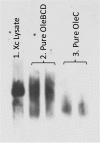Active Multienzyme Assemblies for Long-Chain Olefinic Hydrocarbon Biosynthesis
- PMID: 28223313
- PMCID: PMC5388818
- DOI: 10.1128/JB.00890-16
Active Multienzyme Assemblies for Long-Chain Olefinic Hydrocarbon Biosynthesis
Abstract
Bacteria from different phyla produce long-chain olefinic hydrocarbons derived from an OleA-catalyzed Claisen condensation of two fatty acyl coenzyme A (acyl-CoA) substrates, followed by reduction and oxygen elimination reactions catalyzed by the proteins OleB, OleC, and OleD. In this report, OleA, OleB, OleC, and OleD were individually purified as soluble proteins, and all were found to be essential for reconstituting hydrocarbon biosynthesis. Recombinant coexpression of tagged OleABCD proteins from Xanthomonas campestris in Escherichia coli and purification over His6 and FLAG columns resulted in OleA separating, while OleBCD purified together, irrespective of which of the four Ole proteins were tagged. Hydrocarbon biosynthetic activity of copurified OleBCD assemblies could be reconstituted by adding separately purified OleA. Immunoblots of nondenaturing gels using anti-OleC reacted with X. campestris crude protein lysate indicated the presence of a large protein assembly containing OleC in the native host. Negative-stain electron microscopy of recombinant OleBCD revealed distinct large structures with diameters primarily between 24 and 40 nm. Assembling OleB, OleC, and OleD into a complex may be important to maintain stereochemical integrity of intermediates, facilitate the movement of hydrophobic metabolites between enzyme active sites, and protect the cell against the highly reactive β-lactone intermediate produced by the OleC-catalyzed reaction.IMPORTANCE Bacteria biosynthesize hydrophobic molecules to maintain a membrane, store carbon, and for antibiotics that help them survive in their niche. The hydrophobic compounds are often synthesized by a multidomain protein or by large multienzyme assemblies. The present study reports on the discovery that long-chain olefinic hydrocarbons made by bacteria from different phyla are produced by multienzyme assemblies in X. campestris The OleBCD multienzyme assemblies are thought to compartmentalize and sequester olefin biosynthesis from the rest of the cell. This system provides additional insights into how bacteria control specific biosynthetic pathways.
Keywords: bacteria; hydrocarbon; multienzyme complex; olefin.
Copyright © 2017 American Society for Microbiology.
Figures






References
-
- Albro PW, Dittmer JC. 1969. The biochemistry of long-chain nonisoprenoid hydrocarbons. I. Characterization of the hydrocarbons of Sarcina lutea and the isolation of possible intermediates of biosynthesis. Biochemistry 8:394–405. - PubMed
-
- Friedman L, DaCosta B. April 2008. Hydrocarbon-producing genes and methods of their use. International patent WO/2008/147781.
MeSH terms
Substances
Grants and funding
LinkOut - more resources
Full Text Sources
Other Literature Sources
Molecular Biology Databases

